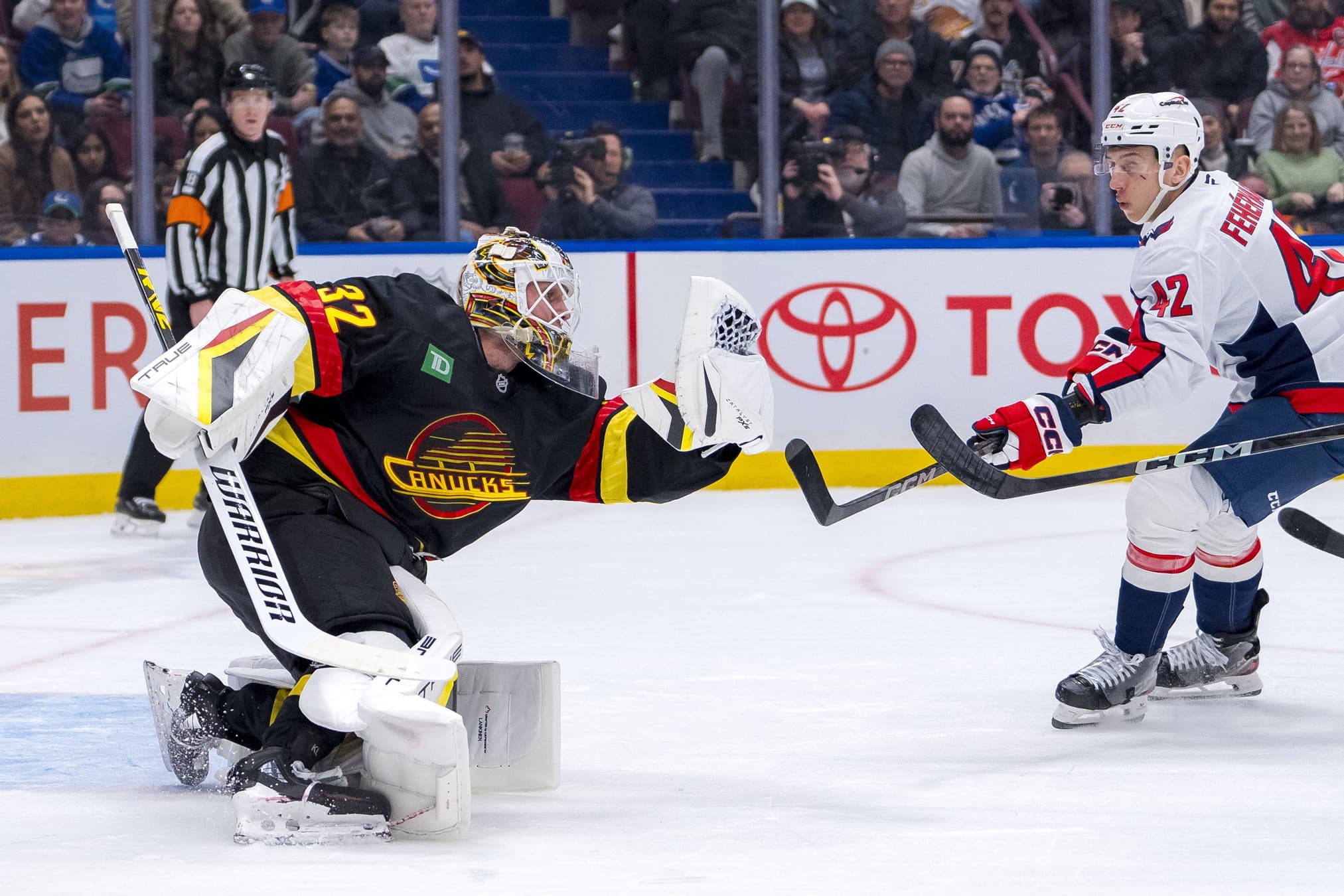Agent Todd Diamond on UFA Kevin Lankinen : I have had some conversations with Patrik Allvin but we don't know the salary cap number, it's common sense for us to wait. Complete interview on @DonnieandDhali and You Tube
Nation Sites
The Nation Network
CanucksArmy has no direct affiliation to the Vancouver Canucks, Canucks Sports & Entertainment, NHL, or NHLPA
Canucks: Does Kevin Lankinen have a track record worth investing in?

Photo credit: © Bob Frid-Imagn Images
Jan 27, 2025, 13:15 ESTUpdated: Jan 27, 2025, 22:21 EST
Quinn Hughes was the name on everyone’s lips this past weekend, and for good reason. He more or less singlehandedly defeated the top team in the league in the Washington Capitals, and deserves all the credit he can get for it.
But if there was a name below his on the Canucks-related discussion marquee, it was definitely that of Kevin Lankinen. Again, with good reason. And the subject of most conversations on Lankinen related to the question of how much share of the Canucks’ crease he should be getting for the remainder of the 2024/25 season – and perhaps beyond that.
It’s not too hard to see why folks are thinking about Lankinen. Aside from Hughes, no one has contributed more to keeping the Canucks’ playoff hopes alive. In fact, aside from Hughes and Lankinen, no one has really contributed to keeping the Canucks’ playoff hopes alive at all.
Lankinen’s impact is especially noticeable right now in contrast to Thatcher Demko’s ongoing struggles. The Canucks’ incumbent starter is coming off an especially lengthy injury absence that left him with plenty of rust, but it’s now been long enough that questions are starting to be asked about his long-term performance.
Over the back-half of January, Demko is 1-3-0 with 16 goals against and a save-percentage below .900 in each and every outing.
Lankinen, meanwhile, battled illness during that same stretch, and still came away at 2-1-0 with seven goals against with a save-percentage of .919. And that’s with Lankinen’s worst performance of the year, against Winnipeg, in the mix.
It is now abundantly clear that, for the time being at least, the Canucks stand a much better chance of winning any given game with Lankinen in net than with Demko.
So, it’s simple, then, no? Lankinen should start as often as possible, and Demko should slide back into the backup role.
Except nothing is ever so simple in this sport, and especially not as it pertains to the Vancouver Canucks.
Lankinen, the bargain signing of all bargain signings, is set to become a UFA at the end of this season. At the same time, the Canucks’ own focus is shifting from this season to future years. Playing Lankinen as the starter is an investment of sorts in him, and the Canucks will have to consider how much investment they want to put into someone who may be departing for greener grasses come the summer.
If they’re going to invest their trust in Lankinen now, it stands to reason that they should also invest some money in him, via a contract extension. Those talks have reportedly at least started.
But even that isn’t as straightforward a decision as one might like. For as good as Lankinen is playing in the 2024/25 campaign, he is a goalie with a limited track record, and that applies risk to any contract extension he might be offered.
Look, we don’t have to tell Canucks’ fans that goaltenders are traditionally mercurial. They’ve lived that truth enough times over. The league annals are littered with one- and two-year wonders.
As we sort goalies by salary on PuckPedia, we can find countless examples who aren’t worth their current deal. Folks like Philipp Grubauer ($5.9m) are no longer of starting quality. Former sure things like Filip Gustavsson ($3.75m) don’t look so sure anymore. Cal Petersen, at $5 million, isn’t even in the league anymore.
The question, then, is how to determine how much of Lankinen’s current success is likely to continue past this year, for how long that continuation might last, and what it might be worth.
Let’s place Lankinen in the context of leaguewide goaltenders first.
You might be surprised to learn that, since entering the league as of the 2020/21 season, Lankinen’s 143 games ranks 35th overall. His 62 wins rank him slightly higher, in a tie for 33rd overall with John Gibson and Ukko-Pekka Luukkonen. By that count, Lankinen’s track record is a little more notable than most would assume at first glance.
If we start sorting by performance-related stats (and filter it by those who played at least 50 games over those five seasons to eliminate statistical anomalies), we find Lankinen, again, in a tie for 35th with a .905 cumulative save-percentage and with the 46th-best goals-against-average at 2.96.
They’re numbers that might suggest the trend of a very good backup. But it’s worth mentioning here that Lankinen’s first two seasons in the league came as a part of a very poor Chicago Blackhawks team.
Let’s take away those two years, and instead isolate the last three from 2022 to present. Over that span, Lankinen’s workload is just 74 games, ranking him 49th amongst goalies. But that can largely be attributed to him spending his time backing up Juuse Saros, one of the league’s busiest netminders, prior to arriving in Vancouver.
Lankinen’s save-percentage over that span is .909, which is tied for the 17th-best in the league with the Cup-winning Adin Hill. In terms of goals-against-average, Lankinen’s 2.69 has him tied with Jacob Markstrom for 19th overall.
Those are numbers more approximating a reasonable starting goaltender. One might even go as far as to suggest that, over this three-year trend including the 2024/25 season, Lankinen has established himself as a top-20 goaltender.
But then the Canucks would probably like to avoid paying him like a top-20 goaltender. Right now, the 20th-highest cap hit for a goalie is $4.5 million.
One cannot help but wonder, if Lankinen’s numbers with Nashville were so good, why he had such a tough time landing an NHL contract this past summer. Ultimately, he waited until September 21 to sign with the Canucks at just $875,000.
But that wasn’t necessarily what he was worth. Lankinen would appear to have misjudged a constricted goalie market, perhaps holding out for a better offer with a more definitive starter role that never materialized. In the end, there are only so many starting jobs.
At that point, we assume Lankinen opted for the option that gave him the best chance of earning a starting job, that being filling in for the injured Demko in Vancouver. And, so far, it’s a mission accomplished.
Sure, it might rankle a bit to go from paying a fellow $875,000 in one offseason to considerably more the next summer, but that shouldn’t get in the way of good business. This season especially, but also over the last couple, Lankinen has certainly proven he deserves more.
So what is more?
The Canucks have a somewhat convenient benchmark present in Demko. When he signed his current $5 million AAV contract, he had less playing experience than Lankinen does now, but was arguably more established as a starter, and was also younger.
Keeping Lankinen around at a lower salary, and then presumably putting Demko on the trade market, would be the goal from here on out if the team chooses to extend Lankinen.
From the stats we’ve gone over, it could be argued that Lankinen deserves something in that same range. At the very least, something that puts him safely within the top-20 at a $4.5 million AAV.
But here’s where the Canucks can point at Lankinen’s other track record and perhaps win themselves a bit of a discount.
Lankinen’s estimated career earnings to this point are ‘just’ $7.825 million. He’s never earned a salary higher than $2 million in a single year, and he’s never signed a contract for a term longer than two years.
Lankinen’s estimated career earnings to this point are ‘just’ $7.825 million. He’s never earned a salary higher than $2 million in a single year, and he’s never signed a contract for a term longer than two years.
Given his experience on the market this past summer, one might assume that Lankinen would appreciate some certainty. Currently, the Canucks are the only team able to negotiate with him and, thus, the only team able to offer that certainty.
One wonders if the Canucks were to offer Lankinen a contract somewhere in the four-year range, whether he might be willing to pair that with a cap hit somewhere in the $4 million range. In doing so, he’d probably be giving up some money he could have theoretically picked up as a UFA. But then we know how that bet went last time for him.
For the Canucks, it’s a length of term that would cover their hoped-for competitive window. For Lankinen, it’d be symbolic of him holding onto the starter’s reins in a spot where he’s finally won them fair and square.
To answer the question in our headline, Lankinen’s track record might seem narrow at first blush, but it’s actually plenty lengthy in the grand context of current NHL goaltenders. And the quality of his goaltending over that track record is high.
High enough for the Canucks to invest in?
It’s certainly looking that way.
Sponsored by bet365
Breaking News
- The Stanchies: Zeev Buium’s two point debut leads the way in Canucks’ 2-1 victory over Devils
- Canucks forward Lukas Reichel clears waivers
- Instant Reaction: Zeev Buium scores game-winning goal in Canucks debut vs. Devils
- Canucks activate Marco Rossi, place Elias Pettersson on injured reserve
- Was this the absolute best time for the Canucks to trade Quinn Hughes?
